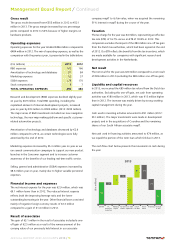TomTom 2013 Annual Report Download - page 16
Download and view the complete annual report
Please find page 16 of the 2013 TomTom annual report below. You can navigate through the pages in the report by either clicking on the pages listed below, or by using the keyword search tool below to find specific information within the annual report.
is similar, whether the navigation system is built in the dash or
provided on a PND, the dynamics of supplying to the automotive
industry are different from those of delivering mass-market
consumer electronics.
There could be additional operational and technical challenges in
growing our automotive business and maintaining profitability in
the long term in such a rapidly evolving environment. Furthermore,
new map and navigation providers may choose to enter the
automotive market, which could significantly increase the level of
competition we face. If we are unsuccessful in maintaining and
growing a profitable automotive business, our financial condition,
results of operations and liquidity may be materially adversely
affected.
Brand
All our products and services are brought to market under one
brand. This leads to brand concentration risk. Brand value can be
severely damaged, even by isolated incidents affecting the
reputation of our business or our products and services. Some of
these incidents may be beyond our ability to control and can erode
consumer confidence in our products or services.
Factors that negatively affect our reputation or brand image, such
as adverse consumer publicity, inferior product quality or poor
service, could have a material adverse effect on our financial
condition and results of operations.
Innovation and engineering capabilities
Our markets are characterised by rapid technological change,
which challenges us to deliver highly competitive products and
services. We will continue to focus on producing high quality
innovative solutions, but there can be no guarantee that our
products and services will compete successfully against current or
new market entrants or competing technologies.
Our success depends on our ability to rapidly develop, market and
commercialise new and upgraded products and services. The timing
of our new product and service releases, our ability to accurately
forecast market demand, our product mix relative to that of our
competitors and our ability to understand and meet changing
consumer preferences are vital to this effort. Should we be unable
to meet these challenges, it may have a material adverse effect on
our financial condition and results of operations.
Digital mapping
The competitive environment requires continuous investment in
new technology for creating and updating map databases. Maps
need to be continuously updated for changes in the environment
and we are continuously adding new geographies to our map
database to be able to meet the needs of existing customers, bring
out new products and expand into new markets.
If we are unable to invest sufficiently to compete in terms of both
the quality and coverage with other global map providers and to
modernise our map delivery platforms, our business, our financial
condition, results of operations and liquidity may be materially
adversely affected.
Dependency on GPS satellites
Our navigation products and services depend on GPS satellite
transmissions that provide position data to our customers. GPS
satellites are funded and maintained by the US government. We
have no control over their maintenance, support or repair. The
availability and free use of GPS signals to the level of accuracy
required for commercial use remain at the sole discretion of the US
government.
GPS signals are carried on radio frequency bands. Any reallocation
of, or interference with these bands could impair the functionality
of our products. Alternate systems are in various stages of
development, but again these systems remain under the control of
sponsoring governments and agencies, and we cannot be certain
that our products and services will be compatible with these new
systems.
Operational risks
Human resources
In order to be a market leader in our industry, we need to have the
most talented people working effectively together. The success of
our business depends on attracting, integrating and retaining highly
skilled personnel in all business units and development centres.
We aim to bring the highest calibre people into our organisation.
We have a rigorous recruitment process, so that we can have high
levels of confidence in the people we hire. To retain talent within
our organisation, we monitor the organisational health of the
company and have programmes in place to retain key employees.
However, if we are unable to attract and retain the high calibre
people we require, our ability to operate our business successfully
could be significantly impaired.
Supply chain
We depend on a limited number of third parties and, in certain
instances, on sole suppliers, for map content, component supply
and manufacturing. Any disruption to or termination of our
relationships with third-party manufacturers, suppliers or
distributors, or any reduction in their ability to supply our needs
would adversely affect our business.
Our capacity to deliver innovative products to the market means
that we will continue to be dependent to some extent on
components that are only available from specific leading
technology organisations. Single-source component risk will
remain a part of our business model for the foreseeable future. If
Management Board Report / Continued
ANNUAL REPORT AND ACCOUNTS 2013 / 16
























